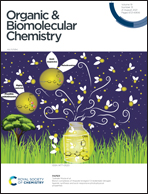Boron complexes of thiazole-bridged 1,5-bidentate nitrogen ligands: synthesis and acid-responsive photophysical properties†
Abstract
Boron complexes of 1,5-bidentate nitrogen ligands with a thiazole linker were synthesized by the halogenation of 5-H thiazoles followed by Buchwald–Hartwig amination and complexation with BF3·Et2O. These boron complexes showed a large Stokes shift of up to 125 nm, which is in marked contrast to that observed for ordinary BODIPYs. The absorption and emission spectra of the boron complexes were almost independent of the substituents in the complexes as well as the solvents used for the measurement. The nitrogen atom of the pyridyl group attached to the thiazole ring acted as a Lewis base which accepted Lewis and Brønsted acids to lead to a prominent red-shift of the absorption bands. Addition of tris(pentafluorophenyl)borane, B(C6F5)3, to the boron complex led to a significant red-shift of the absorption band. Likewise, addition of triflic acid (TfOH) and trifluoroacetic acid (TFA) resulted in the emergence of a new absorption band at a longer wavelength accompanied by fluorescence quenching phenomena. DFT calculations show that the energy gap between HOMO and LUMO of the complex significantly decreases after protonation of the nitrogen atom in the acceptor unit of the boron complex.



 Please wait while we load your content...
Please wait while we load your content...